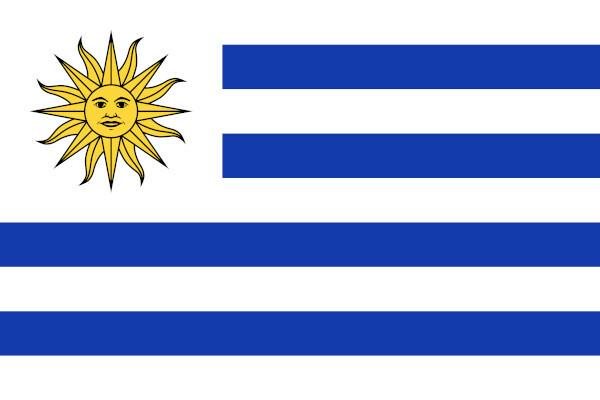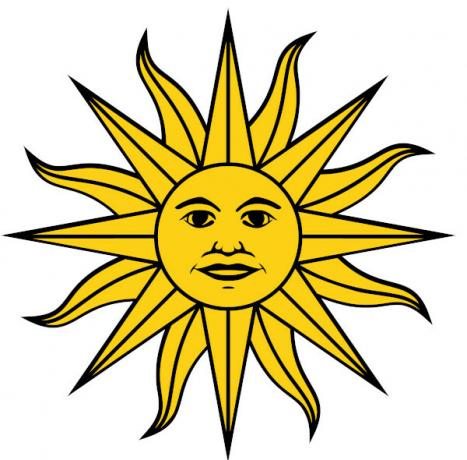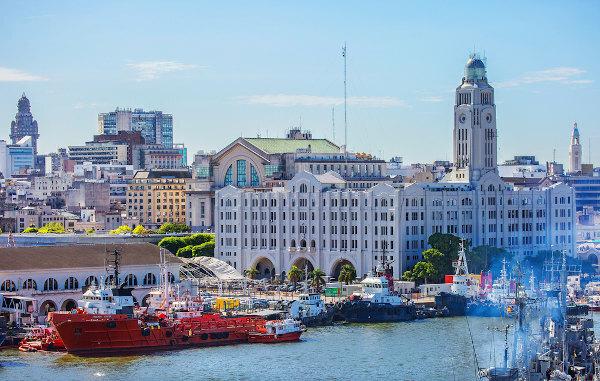A uruguay flag It is a symbol that represents the country. Its current version was adopted in 1830, consisting of nine horizontal bands alternately white and blue, which represent the departments that made up the Uruguayan territory when it was formed, and by the Sun of May in the upper corner left. The Sol de Maio symbolizes independence and freedom, in addition to representing the South American cultural heritage from the incas, with its human appearance made in reference to the Inca Sun god, called Inti.
Read too: Flag of Argentina — another national symbol featuring the Sun of May
Topics of this article
- 1 - Summary about the flag of Uruguay
-
2 - Meaning of the flag of Uruguay
- Meaning of the colors of the flag of Uruguay
- Meaning of the symbols of the flag of Uruguay
- 3 - History of the flag of Uruguay
- 4 - Main characteristics of Uruguay
- 5 - Curiosities about the flag of Uruguay
Abstract about the flag of Uruguay
The flag of Uruguay, also called the National Pavilion, represents the history of the South American country.
It is formed by nine horizontal stripes, alternately white and blue, which represent the nine departments that originally formed the territory of the Uruguay.
In the upper left corner, on a white square, is the Sun of May represented in yellow. This symbol represents independence and freedom.
The human face of Sol de Maio represents the Sun god of the Incas, called Inti.
In 1828, Uruguay adopted a flag with a configuration similar to the current one, but with 19 horizontal stripes.
The current flag of Uruguay was officially adopted on July 11, 1830.
Uruguay has two other official flags: the Artigas flag and the 33 flag.
Uruguay flag meaning
The flag of Uruguay is one of the symbols that represent the country. It has a rectangular shape, and is composed of nine horizontal stripes alternately white and blue. In the upper left corner, next to the mast, there is a white square inside which is represented a Sun with human features, better known as the Sun of May. Also known as the National Pavilion, the Uruguayan flag represents the history of the country's independence and freedom.

Meaning of the colors of the flag of Uruguay
The colors that are present in the flag of Uruguay are the whiteThe, The blue and The yellowThe.
Blue and white are arranged alternately in nine horizontal stripes of the same width in a pattern that begins and ends, obligatorily, with a white stripe. O set of stripes of the flag of Uruguay represents the nine original departments that formed the territory from the country. While there is no official meaning assigned to the individual colors, white is traditionally a color that represents peace, while blue represents the skies and ocean waters, beyond justice.
Yellow is the color of Sol de Maio, a symbol of great importance for the Uruguayan flag and which has a particular meaning, as we will see below.
Do not stop now... There's more after the publicity ;)
Meaning of the symbols of the flag of Uruguay
The symbol that appears represented on the flag of Uruguay is the Sun of May. It features a human face and, in the Uruguayan pavilion, it is represented by a total of 16 rays. These 16 rays are alternately straight and wavy, and each has an internal division. Another important feature of the Sol de Maio flag of Uruguay is the black outline, as you can see in the image.

the sun of may represents the independence of the United Provinces of the River Plate, which included territories such as Uruguay and Argentina. It is said that on May 25, 1810, the sun finally appeared after days of bad weather. This apparition would have happened during a public mass celebrated in support of the independence of the Platine territory, which was seen as a good sign, favorable for those who wanted to free themselves from colony status Spanish.
To the human features present in Sol de Maio, in turn, represent the Inca god Inti (or Apu-punchau), who corresponded to the Sun god of that pre-Columbian civilization.
Read too: Flag of Brazil — the history and meaning of this national symbol
History of the Flag of Uruguay
O current Uruguayan territory corresponded to the Banda Oriental of the United Provinces of the Río de la Plata, who gained their independence in 1816. Its flag represented the entire platinum territory and was composed of three horizontal stripes of the same dimensions, two sky blue stripes with a white stripe in the center.
Several other flags have represented Uruguay since then, one being the flag of Cisplatina, which was in force between 1821 and 1825, when the nation gained its independence from to Brazil. The new Uruguayan flag then consisted of horizontal stripes in blue, white and red.
In 1828, however, the country adopted a pavilion similar to the current one.. It was then formed by 19 horizontal stripes alternately white and sky blue, with ten white and nine blue stripes. These alone represented the Uruguayan districts. The Sun of May, already present on the flag, was formed only by rectilinear rays, unlike the current one, which has straight and wavy rays. The current configuration of the flag of Uruguay was officially adopted on July 11, 1830.
Main characteristics of Uruguay
Uruguay, also known as the Oriental Republic of Uruguay, is a country South American located in the southern region of the subcontinent. Its capital is the city of Montevideo. The Uruguayan territory is bathed to the east by the Oatlantic oceanestablishing a land border with the Brazil and with Argentina, respectively to the north and west.
A location and maritime characteristics give the country a subtropical climate, with the definition of the four seasons and recurring rains. The Uruguayan relief is modest, formed by flat and gently undulating terrain, with its culmination, Mount Catedral, located 514 meters above sea level. altitude.

With approximately 3.5 million inhabitants, Uruguay is a sparsely populated and sparsely populated country, with demographic density of only 19.8 inhab./km². While representing one of the least populous countries in Latin America, its economy can be considered one of the most developed in the subcontinent. It is based on the tertiary sector, in which foreign trade and tourism weigh.
A industry in the country is quite diversified, comprising sectors ranging from food processing to the manufacture of electrical equipment. Also noteworthy is the fact that the country presents one of the biggest HDI from south america, which is 0.809, second only to Chile and Argentina.
Curiosities about the flag of Uruguay
-
The National Flag is not the only official flag of Uruguay. Two other flags are also used by the country:
Flag of Artigas, made up of three bands in the blue-white-blue pattern with a diagonal red band across them. It was made by José Gervasio Artigas and is used in his honor, since the soldier is considered a Uruguayan hero who fought for the country's independence. The flag was made official as a national symbol in 1952.
Flag of the 33, formed by three horizontal bands in blue, white and red. The following words can be read on the central white band: “Libertad o Muerte”. It was made during the Cruzada Libertadora, which marked the struggle for Uruguayan independence from Brazil in 1825. Its name refers to the men belonging to the 33 Orientales movement, led by Juan Antonio Lavalleja.
The three flags are hoisted together during national festivities. On these occasions, the National Flag must always be in the center, with the flag of Artigas obligatorily on the right and the flag of the 33 on the left.
image credits
[1] Galina Savina / Shutterstock
By Paloma Guitarrara
Geography Teacher
Read our text and deepen your knowledge about South America. Learn more about the geography, economy, culture and history of this subcontinent.
Click to read our text about the flag of Argentina and learn about the history of this important national symbol for the country. Understand the meaning of the Sun of May.
Did you know that Uruguay was once part of Brazil? Click and learn a little more about the second smallest country in South America.


